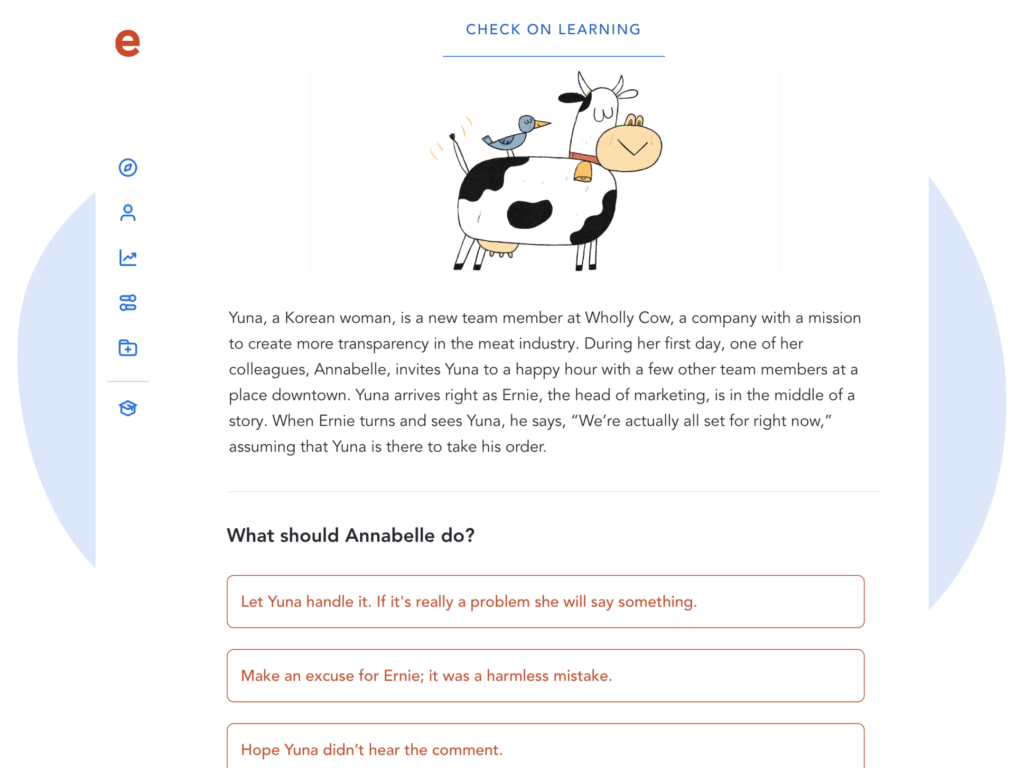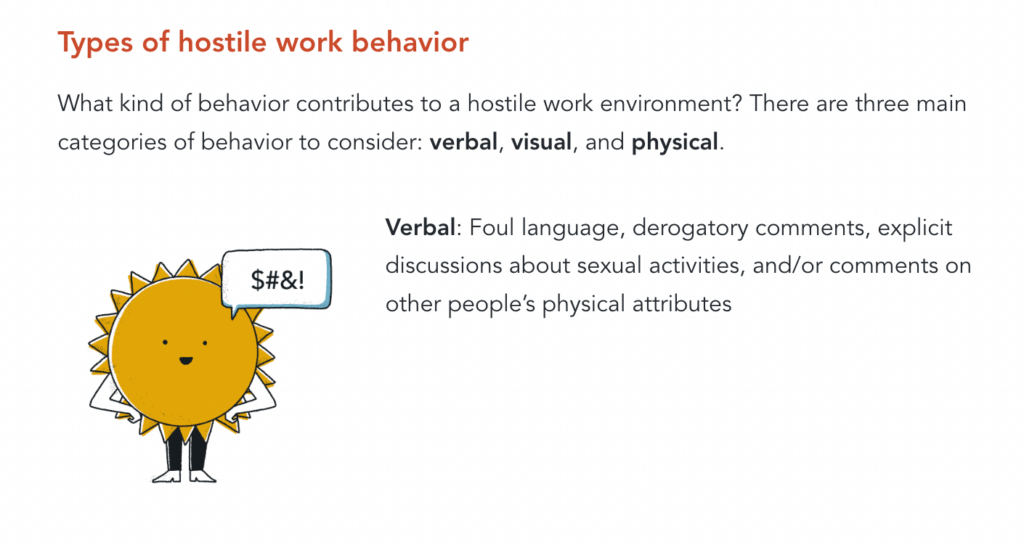Please please please don’t quote us out of context on this, but you actually don’t need workplace harassment training. Stay with us: what you need is effective workplace harassment training. (You can unclench all your muscles now. Or were we the only ones who were tense even writing that?)
But seriously, anything less than effective training on harassment in the workplace is costing you twice — once in the time, money, and resources required to onboard, and then again when none of it sticks and your organization is rife with miscommunications, resentment, and potentially problematic behavior.
And we aren’t singling out you or any particular company, by the way; a recent study suggests that nearly a quarter of global employees have experienced workplace harassment or violence during their time in the workforce. That number is large enough to emphasize once and for all how crucial this issue is to address.
So let’s address it.

Why is workplace harassment training important?
In the previous paragraph, we mentioned the cost of ineffective or the lack of workplace harassment training — but what exactly did we mean by that? Why is workplace harassment training important?
Well, the financial toll does figure into these calculations, but it’s far from the only factor to consider. In fact, there are four main ways that subpar corporate harassment training ultimately ends up costing your organization.
4 ways bad workplace harassment training hurts your bottom line
1. It increases harassment
This is a rough one, but it turns out that the way we approached sexual harassment training for employees for, oh, the past three decades was not only ineffective but in some cases, it actually made harassment worse.
As the industry reinvents itself, modern sexual harassment in the workplace trainings (like ours!) are moving away from check-the-box approaches that apply blanket condemnations to large swaths of people without supplying context or best practices. Now they lean toward thoughtful, relevant scenarios, multimedia options that aren’t grainy, out-of-date videos, and teaching tools like Bystander Intervention.
This is great news for anyone on our platform today, but a real bummer for anyone who trained over the last 30 years or so.

2. It doesn’t move the needle in the workplace
We’ve already discussed the sad truth that ineffective training just doesn’t work. But in stark contrast, good training is effective training, and the research bears that out. A Gallup poll that asked respondents to rate their training on a five-point scale found that of those who rated their training as excellent (a full five out of five), 84% strongly agreed with the statement that they knew how and where to escalate workplace concerns. (That’s in comparison to those who rated their training a one, two, or three out of five, who were actually less likely to know where to bring issues than they had been before they took the training.)
That’s a big miss, but it’s also why Ethena puts so much emphasis on training quality. We work with:
- Subject matter experts
- Published writers and editors
- Talented illustrators
- Graphic novelists
- And video producers
To produce content we can be proud of, that meets the learner where they are, and that actually works. Did we mention we have an overall learner approval rating of 92% across all courses? Well, we have an overall learner approval rating of 92% across all courses and over one million positive ratings … just saying. 🥳
3. It does actually cost you money
We get it: sometimes there are so many things on your plate that even with all the ethical incentives, it’s hard to move your search for the perfect harassment in the workplace training platform from the “nice-to-have” list to the “need-to-have” list. (From what we’ve heard, a lot of you are working with extremely lean People teams — and some of you are operating as a one-person HR department Googling, “Is workplace harassment training mandatory?”, so we really do get it.)
So if you need help shifting the priority scales a bit, please know that there are financial incentives here as well. Failure to implement an effective training program and adhere to legal requirements can result in:
- Fees
- Fines
- Lowered employee morale
- And employee attrition even if nothing specifically goes wrong.
And if you do have a workplace incident, a lackluster program can leave you facing costly litigation or lawsuits, not to mention suffering incalculable reputational loss.
4. It could lead to a hostile work environment
We tend to believe that the majority of folks are well-intentioned, so it’s important that they’re kept informed about what’s acceptable and what isn’t. Without those communications and structure in place, it isn’t difficult for a workplace to turn toxic, for microaggressions to blossom unchecked, for quid pro quo relationships to spring up, or even to find yourself functioning in a full-blown hostile work environment.
And since we don’t want any of that for you, we think it’s best to get ahead of these behaviors before they have a chance to take root. One excellent place to start? Ethena’s flagship Harassment Prevention training, where we explain all the above concepts and more.

Harassment training in the workplace: Why Ethena’s?
So you might find yourself wondering: what makes Ethena qualified to tell me how to run my harassment training in the workplace program? Let alone, ask me to purchase theirs?
Bad sexual harassment in the workplace training is why we were founded.
Our CEO Roxanne Petraeus was a woman in the Army, where she both witnessed and experienced rampant harassment, some of which she didn’t have the vocabulary to describe at the time, and all of which went largely unaddressed by leadership. She brought her learnings back to civilian life with her, and co-created a company dedicated to ensuring that she was part of the solution to what we can all agree is a global issue.
Our corporate harassment training meets employees where they are.
Part of that solution means modernizing corporate harassment training to embrace hybrid and remote-only organizations, and addressing the unique harassment “opportunities” that those scenarios create. Aka you can keep your grainy 90s footage of men in ill-fitting suits putting their hands on coworkers and calling the women in the office “sugarcakes.” Harassment is rarely that cut and dry, so we put our focus on the gray areas. (Although please do not be out there touching knees or referring to your coworkers by pet names. That’s gross and we all know it.)
Harassment training for employees needs to be modern.
And we change with the times. No harassment training ages well, and we’re prepared for that. Not only do we stay up-to-date on new and changing technologies and terminologies, but we also keep on top of changing regulations so you don’t have to sweat them.
We make it easy to start and stay up-to-date.
We’ve put a lot of emphasis in this particular post on what we do for the learners, but that doesn’t mean we’ve forgotten you administrators! Our engineering team has put together a staggering swath of software integrations that make onboarding a literal breeze.
And once you’re in, we keep up with changing regulations, amendments, and laws so you don’t have to. One recent example is the new Chicago sexual harassment training requirements that went into effect in 2022. (Which you should definitely check out if you have employees who reside in Chicago, by the way!)
We worked with our lawyers to produce an hour-long bystander intervention training that complies with the new ordinances without missing a beat.
Ready to launch Ethena’s harassment training in the workplace?
We’re hoping so, but we also won’t be offended if you aren’t quite convinced. (Picking out a harassment training provider or switching from another product is a big deal — we get it!)
While you weigh your options, feel free to request a sample of our Harassment Prevention training today, or talk to a member of our stellar sales team. They’ll be able to address any questions or concerns you have, so we can get you and your team squared away in no time.










